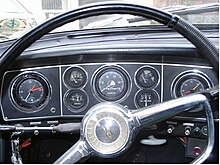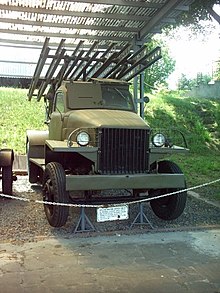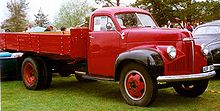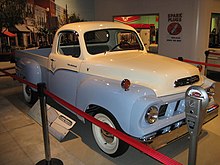Studebaker Corporation

Studebaker was an American brand name for wagons , carriages , automobiles , utility vehicles , industrial products, and armaments . The company was founded on February 16, 1852 as a forge. In 1868 it was registered as the Studebaker Brothers Manufacturing Company . From 1911 to 1954 and from 1961 to 1966 it operated as the Studebaker Corporation . In the meantime it merged with the smaller Packard Motor Car Company to form Studebaker-Packard Corporation , which was de facto in 1958 and formally terminated in 1961. Studebaker withdrew from the automotive industry in 1966 and was called Studebaker-Worthington in the last few years of its existence .
Early history
The company dates back to the German-born family perennials Becker (later mare Becker), which for generations as a cutler in Solingen was established. Part of this family around the brothers Peter (1698–?) And Clement Stutenbecker and their cousin Heinrich Stutenbecker († March 3, 1756) emigrated in 1736 via the Netherlands and came to Philadelphia ( Pennsylvania ). Heinrich Stutenbecker and his wife were killed by rebellious Indians in 1756.
Peter, Clement and Heinrich Studenbecker had to give up their original job as a cutler because they wanted to emigrate and worked as a blacksmith, farrier and wheelwright. They first settled in Huntingdon Township ( York County in Pennsylvania).
Peter Studebaker's son Peter Jr and grandson John Studebaker (1799–1877) also carried out these professions. John married in 1820. Around 1830 he started his own business in Gettysburg, Pennsylvania. As early as 1835 he sold the land and property and moved with his family to the west. He settled in Ashland County in southwest Ohio . The family had ten children. He taught all five sons, Henry (1826–1895), Clement ("Clem"; 1831–1901), Jacob F. (1844–1887), John M. (1833–1917) and Peter Everest (1836–1897) the Wagner trade.
H. & C. Studebaker Wagon Company
A joint operation by Henry and Clem Studebaker is documented in South Bend from 1852 . The H. & C. Studebaker Wagon Company was located at the intersection of Michigan and Jefferson Streets . At first she manufactured metal parts for freight cars and later took on the production of complete wagons . At the beginning you could also have horses shod here. John Studebaker had also moved to South Bend with his family in 1850 or 1851. The first major expansion of the business was driven by the demand created by the California gold rush of 1849. The company began with the production of vans of Conestoga type, which the Studebaker had not invented, but improved and helped him to spread.
John M. Studebaker also went to California to search for gold in 1853 . When he realized that he would not make a fortune with it, he switched to the successful production of wheelbarrows and later carts for the prospectors and miners in the town of Dry Diggins, nicknamed Hangtown in these troubled times . It's called Placerville today . Peter Studebaker meanwhile built wagons in Saint Joseph, Missouri . In 1857 he opened a repository called the first branch in Goshen (Indiana) . In the same year, the first Studebaker carriage was delivered for pure passenger transport. Studebaker customers included US President Abraham Lincoln (1809–1865).
When the gold rush subsided, John Studebaker returned to Indiana in 1858. He had about 8,000 dollars in savings. He invested this money to buy his brother Henry's shares and become a partner, as well as in the company itself, which urgently needed capital for expansion. Henry Studebaker retired to his farm; Because of his strongly pacifist faith, he had trouble with the fact that the US Army was increasingly part of the customer base.
Studebaker Brothers Manufacturing Company
The next expansion was as a result of the delivery of cars to the Union Army during the American Civil War . According to the motto always give more than you promise , they reorganized themselves into the Studebaker Brothers Manufacturing Company in 1868 . Clem Studebaker became president of the company, in which three of his brothers held important positions.
At that time, the railroad and steamship companies were already dominating freight traffic in the east. So they focused on private customers and farmers. A total of 30 different types of carriages and wagons were offered.
At the height of the development of the west and the columns of covered wagons, half of the wagons were wholly or partially built by Studebaker: they built a quarter themselves and supplied the metal fittings for another quarter to other manufacturers in Missouri . In 1872, Studebaker described himself as “the world's largest manufacturer of carriages and wagons”, a title that was also claimed by the Durant-Dort Company in Flint ( Michigan ). William C. Durant (1861-1947) was involved in this company ; it was one of the germ cells of General Motors .
In 1885, 75,000 vehicles were built, two years later sales exceeded $ 2 million for the first time and by the 1890s, $ 3 million.
Automobile production from 1897 to 1966
Studebaker was already busy with motor vehicles in 1897, but they were powered by electric motors. The company entered into a sales agreement with the Everitt-Metzger-Flanders Company ; EMF made the vehicles and Studebaker sold them through its sales network for carriages and wagons. Supposedly there were quality problems with EMF, so the vernacular in EMF of Every Morning Fix-it , dt. Every morning fix , spoke. JM Studebaker was dissatisfied with the poor quality at EMF and took control of the company in 1910. In order to repair the damage caused at EMF, Studebaker reportedly paid mechanics for a total of one million US dollars who came home to dissatisfied customers and replaced defective parts in the vehicles. This procedure was by no means unusual; Before nationwide dealer networks existed, vehicles were often delivered by rail and the new owners were briefed by a representative who had traveled with them. The EMF Company also failed because of disputes in the management and was dependent on Studebaker without its own sales force.
Studebaker Corporation

In 1911, the Studebaker Brothers Manufacturing Company took over the EMF Company ; this resulted in the Studebaker Corporation . In this way, Studebaker got its own car production facility without having to develop an automobile itself.
Studebaker also began manufacturing trucks , which gradually supplanted horse-drawn carts. In 1920 the wagon division was sold to the Kentucky Wagon Manufacturing Company in Louisville ( Kentucky ). With this step, the company was the only one to complete the conversion from a carriage to an automobile manufacturer. Studebaker was the first American automobile manufacturer to open a controlled test track in 1926. In 1937, the company planted 5,000 pine trees in a pattern that resulted in the word STUDEBAKER when viewed from overhead planes.
Many models from the 1920s that helped Studebaker generate good sales were powered by six-cylinder engines. From the 1920s to the 1960s, Studebaker produced many stylistic and technical milestones, including the President (1929–1932) and the 1939 Champion. In keeping with the American tendency to transform a successful model into a new brand, Studebaker launched two Cheap brands: Rockne and Erskine . In 1929 the first Studebaker with an in-line eight-cylinder engine was brought onto the market. Studebaker used this engine until the 1950s. From 1951 Studebaker also offered a V8 engine . Studebaker built models that would appeal to the average American and meet their mobility needs.
However, rising wage costs (Studebaker never had an auto union strike and wages and pension contributions were the highest in the industry) combined with quality control issues and strong competitive pressures from Ford and General Motors in the early 1950s led to it the financial situation worsened. Professional financial advisors have suggested focusing on short-term income rather than pursuing a longer-term vision. There were enough reserves for another ten years, but tough competition and price dumping by the three major automobile manufacturers doomed the company.
Intermezzo: Studebaker-Packard Corporation
In the hope of stopping the downward trend and stabilizing the market position , Studebaker merged with Packard in 1954 ; the new company was called Studebaker-Packard Corporation with Packard President James J. Nance as President of the new Corporation. Studebaker chairman Harold Vance became vice president. In fact, it was a takeover of the big (Studebaker) by the small (Packard) and one of two bad solutions that were available. The alternative "going it alone" would have led Studebaker into bankruptcy in a very short time . The "big" solution, a network of the four independent manufacturers (Studebaker, Packard, Nash and Hudson ) was planned, but remained unfinished after the death of the Nash Kelvinator boss George W. Mason . In 1954 the American Motors Corporation emerged from the acquisition of Hudson by Nash; In their realignment to the lower market segment, the four-brand solution from Mason no longer suited.
Packard misjudged Studebaker's financial position prior to the merger; it was far worse than Packard's leadership assumed. The numbers given to each other had not been checked “among gentlemen”. Packard had assumed a break-even point at Studebaker of 168,000 units and only discovered in November 1954 that it was far worse: The breakeven point was over 286,000 cars a year, whereas the company had only produced 82,000 vehicles in 1954. Things looked a little better at Packard. With a breakeven point of 80,000 units, 55,247 cars were built in the shortened model year 1955. That was inadequate, but it was a clear step forward compared to the 30,965 outdated vehicles of the correspondingly longer model year 1954.
Studebaker could not have continued to exist without the merger, but the Studebaker-Packard Corporation was also unable to recover. In order to avert bankruptcy, Nance went to a takeover offer from the arms company Curtiss-Wright and then resigned. The new owner was able to make tax write-offs and eliminate a rival in the arms business. Studebaker-Packard gave up all military production facilities including supply contracts to Curtiss-Wright and the production site in Detroit. All remaining automotive activities were relocated to South Bend (Studebaker's facility).
This is the reason for the existence of the Packard models with Studebaker technology, known as "Packardbaker" : The versions of the Studebaker President (1957–1958) and the Studebaker Golden Hawk , which were now also sold as Packard Hawk (" Badge Engineering "). This was an emergency solution with innovative approaches like the first facelift with plastic parts. Packard could no longer offer a competitive car in the upper class ( Cadillac , Lincoln , Imperial ) or even in the upper middle class ( Buick , Oldsmobile , Mercury , Dodge ), money and the prospects of success were lacking and the plant needed capacity for the new compact car Studebaker Lark . The last Packard appeared in 1958. Apart from the few Packard engines in the Studebaker Golden Hawk, the real purpose of the merger, to enable rationalization through larger batch sizes , never materialized. In order to remain present in the upper class, Studebaker-Packard tried to get the US agency for Mercedes-Benz , whereupon many Studebaker dealers also sold their cars.
Studebaker Corporation again


Financial constraints dictated that the Studebaker Lark compact car presented in 1959, which was extremely important for the brand , had to build on old technology. The V8 engine had already appeared in 1952, the chassis was introduced in 1953 and only shortened for the Lark. The body structure was derived from the 1955 facelift, which in turn had already been a facelift. Nevertheless, the Lark temporarily saved the company. When the market segment began to fill with compacts from the major suppliers, the aging Lark lost its competitiveness. After all, the Lark was the only Compact with a V8 engine until 1963 .
It was not until 1962 that the Packard name disappeared from the company name.
One result of the lack of funds was, curiously enough, the Studebaker Avanti sports car , which was presented in 1963. It was easy to manufacture with the existing technology (it was based on the Lark) and received an extremely light, clearly drawn body made of GRP , which reduced production costs. The design for it comes from Raymond Loewy . The car was intended as an image carrier and available with performance-enhanced V8 engines; the manufacturer described it with some justification as the "fastest production car in the world".
At around the same time, designer Brooks Stevens was working on a revision of the Lark, which led to new model names, and on a show car in the style of the Mercedes-Benz SSK from 1928. Studebaker was not uninterested, but did not pursue the project of a small series for cost reasons . The fact that the new Avanti should not have any competition from in-house should also have played a role. From 1964 Stevens produced the Excalibur in its own factory in Milwaukee , initially with Studebaker technology (Series I) and later increasingly with components from the Chevrolet Corvette C3 .
Also from 1963 onwards, three prototypes were built at Carrozzeria Sibona-Basano in Turin on a low budget , which Stevens had planned for the model years 1964 to 1966, including the Studebaker Scepter; At the same time, Loewy designed body variants for the Avanti , which were produced as individual pieces by the French bodybuilder Pichon-Parat . Ultimately, however, in 1963/64 Studebaker lacked the financial means to put these new models into series production.
In December 1963, the company gave up operations in South Bend and sold the Avanti brand to Nate Altman , who continued production of the car under the name Avanti II there. Commercial vehicle production was abandoned and automobile production was relocated to the last remaining site in Hamilton , Ontario, where Studebaker produced until May 1966, before the company withdrew entirely from this sector.
Many Studebaker dealers then switched to Mercedes-Benz . The proving grounds were purchased from former supplier Bendix Corporation , who later gave the land away to the St. Joseph County, Indiana park administration for use as a park . As a condition for the donation, the park was named Bendix Woods .
Studebaker-Worthington
After 1966, Studebaker continued to exist as a closed investment group, whose income it drew from various subsidiaries , including STP , Gravely Tractor , Onan Electric Generators and Clarke Floor Machine . Studebaker was bought by Wagner Electric in 1967 . They then merged with the Worthington Corporation and formed Studebaker-Worthington before it was acquired by McGraw-Edison in 1979 . McGraw-Edison was then bought by Cooper Industries in 1985 , but all of its automotive operations were sold to Federal-Mogul a few years later .
As reported by Forbes Magazine in a 2004 article about firms that survived the 1929 stock market crash , the automaker's remains still exist as Studebaker-Worthington Leasing , a subsidiary of the State Bank of Long Island .
Models
Passenger car until 1942
Passenger cars from 1946
| construction time | model series | annotation | image |
|---|---|---|---|
Compact class |
|||
| 1957 to 1958 | Scotsman | Simplified Champion , Initially Scotsman Champion , cheapest car in America at the time | |
| 1959-1961 | Lark | Compact car |

|
| 1962-1966 | Lark | Significant facelift to further reduce costs |

|
| 1963-1966 | Wagonaire | Station wagon based on the Lark | |
Middle class |
|||
| 1946-1952 | champion | First model after the war |

|
| 1953-1956 | champion | New, unusually flat model |

|
| 1957-1958 | champion | last generation | |
| 1954-1956 | Conestoga | Combination based on the Champion | |
Full size |
|||
| 1947-1958 | Commander | Model change analogous to the champion |

|
Upper class |
|||
| 1947-1954 | Land Cruiser | Extended commander |

|
| 1955-1958 | President |

|
|
Coupe |
|||
| 1956-1964 | Hawk | Coupé based on the Champion |

|
| 1963 | Avanti | Sports coupe |

|
Commercial and military vehicles

| Model year | Models |
|---|---|
| 1937 | Coupe Express |
| 1938 | Coupe Express |
| 1939 | Coupe Express |
| 1940 | Coupe Express , M series |
| 1941 | M series , US6 |
| 1942 | M-series , US6 , M29 Weasel tank |
| 1943 | M-series , US6 , M29 Weasel tank |
| 1944 | M-series , US6 , M29 Weasel tank |
| 1945 | M-series , US6 , M29 Weasel tank |
| 1946 | M series |
| 1947 | M series |
| 1948 | M series |
| 1949 | |
| 1950 | |
| 1951 | |
| 1952 | |
| 1953 | |
| 1954 | |
| 1955 | |
| 1956 | Transtar |
| 1957 | Transtar |
| 1958 | Transtar , Scotsman |
| 1959 | Scotsman |
| 1960 | Transtar , champ |
| 1961 | Transtar , champ |
| 1962 | Transtar , champ |
| 1963 | Transtar , champ |
| 1964 | Champ |
literature
- James H. Moloney: Studebaker Cars. Crestline Publishing, Sarasota FL 1994, ISBN 0-87938-884-6 . (English)
- Terry Ehrich (Ed.): The Hemmings Book of Postwar American Independents. Hemmings Motor News, Bennington VT 2002, ISBN 1-59115-001-9 . (contains a driving report from Special Interest Auto. about the Studebaker Avanti )
- Beverly Rae Kimes (ed.), Henry Austin Clark Jr.: Standard Catalog of American Cars 1805-1942. 3. Edition. Krause Publications, Iola WI 1996, ISBN 0-87341-428-4 . (English)
- John Gunnell (Ed.): Standard Catalog of American Cars 1946–1975. 4th revised edition. Krause Publications, Iola WI 2002, ISBN 0-87349-461-X . (English, CD-ROM / PDF)
- John Gunnell: Standard Catalog of American Muscle Cars 1960–1972. Krause Publications, Iola WI 2006, ISBN 0-89689-433-9 . (English)
- Richard v. Frankenberg, Marco Matteucci: History of the Automobile. Sigloch Service Edition / STIG, Turin 1973, ISBN 3-8003-0100-8 .
- Hans-Otto Neubauer (ed.): Chronicle of the automobile. Chronik-Verlag in Bertelsmann Lexikon-Verlag, Gütersloh / Munich 1994, ISBN 3-570-14338-4 .
- Harald H. Linz, Halwart Schrader : The great automobile encyclopedia. 100 years of history. 2500 brands from 65 countries. 2nd Edition. BLV Buchverlag, Munich / Vienna / Zurich 1992, ISBN 3-405-12974-5 .
- Ferdinand Hediger: Classic Cars 1919–1939. Hallwag-Verlag, Ostfildern 1998, ISBN 3-444-10348-4 .
- Roger Gloor: Post War Car. Passenger cars 1945–1960. Edited by Automobil Revue. 2nd Edition. Hallwag-Verlag, Bern / Stuttgart 1982, ISBN 3-444-10263-1 .
- Roger Gloor: Passenger Cars of the 1960s. 3. Edition. Hallwag-Verlag, Ostfildern 1998, ISBN 3-444-10307-7 .
- George Nick Georgano (Ed.): Complete Encyclopedia of Motorcars, 1885 to the Present. 2nd Edition. Dutton Press, New York 1973, ISBN 0-525-08351-0 . (English)
- GN Georgano (Ed.), G. Marshall Naul: Complete Encyclopedia of Commercial Vehicles. MBI Motor Books International, Osceola WI 1979, ISBN 0-87341-024-6 . (English)
Web links
- History of the Studebaker Family and Company studebakerfamily.org
- Smithsonian Institute: From Horses to Horsepower - Studebaker Helped Move a Nation
Individual evidence
- ^ History of the Studebaker Family and Company studebakerfamily.org
- ↑ First Generation studebakerfamily.org (English)
- ↑ a b Studebaker Museum Hagerstown: A. Erskine Exhibit bakerslookout.com (English)
- ↑ a b c Studebaker coachbuilt.com (English)
- ↑ Automotive Hall of Fame: John M. Studebaker (English)
- ^ A b Smithsonian Institute: From Horses to Horsepower - Studebaker Helped Move a Nation
- ^ Kimes: Standard Catalog , 1996, p. 1409.
- ↑ Kentucky Wagon Manufacturing Company coachbuilt.com (English)
- ^ Richard von Frankenberg and Otto Neubauer: History of the automobile. Sigloch Edition, Künzelsau, ISBN 3-89393-197-X , p. 285.
- ^ Ward: Fall of the Packard Motor Car Company (1995), pp. 167-168
- ↑ packardinfo.com: Packard Model Information / 1955 Model Year
- ↑ packardinfo.com: Packard Model Information / 1954 Model Year
- ↑ Don Francisco: Bonneville Wrap-Up , Hot Rod Magazine, January 1964, pp. 80–83 (PDF; 8.8 MB)
- ^ Asa E. Hall, Richard M. Langworth: The Studebaker Century: A National Heritage . Dragonwyck Publishing Inc., Contoocook, New Hampshire, 1983, ISBN 978-0-96061-481-3 , p. 387 (English).
- ↑ 1960s Studebaker Concept Cars howstuffworks.com (English)











